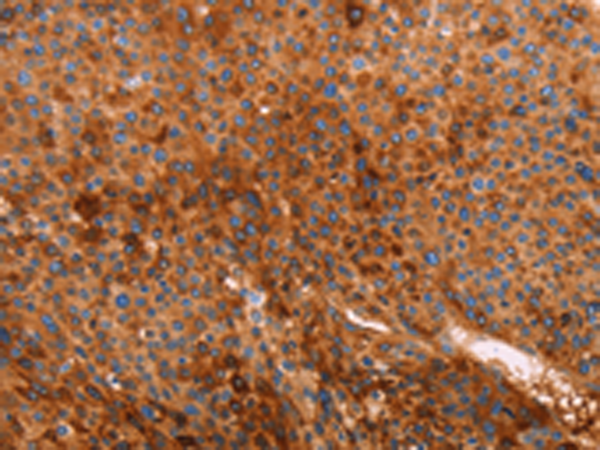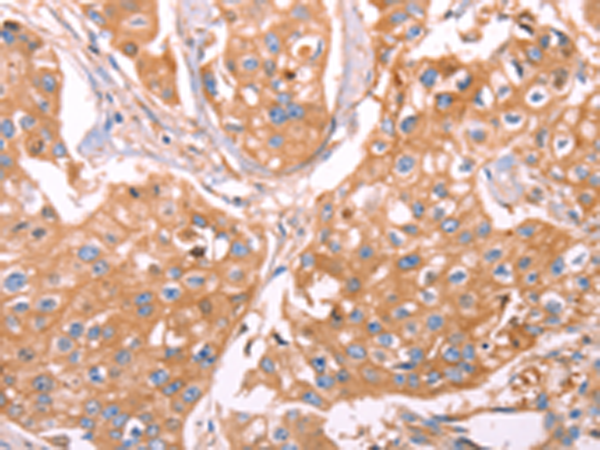


| WB | 咨询技术 | Human,Mouse,Rat |
| IF | 咨询技术 | Human,Mouse,Rat |
| IHC | 1/50-1/200 | Human,Mouse,Rat |
| ICC | 技术咨询 | Human,Mouse,Rat |
| FCM | 咨询技术 | Human,Mouse,Rat |
| Elisa | 1/2000-1/5000 | Human,Mouse,Rat |
| Aliases | DBP; GRD3; VDBG; VDBP; DBP/GC |
| WB Predicted band size | 53 kDa |
| Host/Isotype | Rabbit IgG |
| Antibody Type | Primary antibody |
| Storage | Store at 4°C short term. Aliquot and store at -20°C long term. Avoid freeze/thaw cycles. |
| Species Reactivity | Human |
| Immunogen | Fusion protein of human GC |
| Formulation | Purified antibody in PBS with 0.05% sodium azide and 50% glycerol. |
+ +
以下是关于GC抗体(抗肾小球基底膜抗体)的3篇参考文献,简要整理如下:
---
1. **文献名称**: *Identification of the Goodpasture antigen as the alpha 3(IV) chain of collagen IV*
**作者**: Saus, J., Wieslander, J., Langeveld, J.P., et al.
**摘要**: 该研究首次鉴定出Goodpasture综合征的靶抗原为IV型胶原蛋白的α3链(COL4A3),揭示了自身抗体与肾小球基底膜的结合机制,为理解疾病发病机制奠定了基础。
---
2. **文献名称**: *Anti-glomerular basement membrane antibody diseases: an update on subgroups, pathogenesis and therapies*
**作者**: Salama, A.D., Levy, J.B.
**摘要**: 综述文章系统总结了抗GBM抗体疾病的临床亚型、病理机制及治疗进展,强调抗体介导的肾肺损伤过程,并讨论了血浆置换与免疫抑制治疗的疗效。
---
3. **文献名称**: *Clinical significance of anti-GBM antibody detection: a multicenter study*
**作者**: Sinico, R.A., Radice, A., Corace, C., et al.
**摘要**: 多中心研究评估了酶联免疫吸附法(ELISA)检测抗GBM抗体的敏感性和特异性,提出其在快速诊断Goodpasture综合征及鉴别其他肾小球疾病中的关键作用。
---
如需更多文献或特定领域的参考文献,请进一步说明。
GC antibodies, also known as anti-glomerular basement membrane (anti-GBM) antibodies, are autoantibodies targeting type IV collagen in the basement membranes of glomeruli and alveoli. First identified in the 1960s, these antibodies are primarily associated with Goodpasture syndrome, a rare autoimmune disorder characterized by rapidly progressive glomerulonephritis and pulmonary hemorrhage. The pathogenic antibodies bind to the non-collagenous (NC1) domain of the α3 chain of type IV collagen, triggering complement activation and inflammatory damage.
Genetic and environmental factors, such as HLA-DR15 susceptibility and hydrocarbon exposure, may contribute to disease onset. Diagnosis relies on detecting circulating anti-GBM antibodies via ELISA or immunofluorescence, alongside kidney biopsy showing linear IgG deposits. While historically fatal, advancements in immunosuppressive therapies (e.g., cyclophosphamide, corticosteroids) and plasma exchange have significantly improved survival rates.
Interestingly, low titers of anti-GBM antibodies occasionally occur without clinical disease, suggesting complex immune regulation. Research continues to explore epitope-specific antibody profiles and novel biologics for refractory cases. GC antibody-mediated diseases exemplify the interplay between autoimmunity and organ-specific pathology, emphasizing early detection and targeted intervention.
×